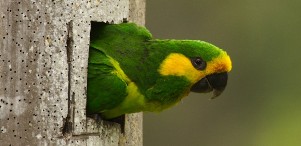
The Yellow-eared Parrot is gregarious, traveling and sleeping in flocks. Is nomadic and mobile, often traveling to favorable locations in the same times in one season.
The nests are placed very close to the rest areas of the most numerous herds. Adult individuals turn to be very noisy while raising their chicks, especially in the afternoon as they claim the attention and supervision of bigger herds. This cooperation among birds that are raising chicks and the ones hat are not is very positive for the nests because it works as an effective alarm against predators. There is a very distinctive behaviour in the Yellow-eared Parrot (Ognorhynchus icterotis), consisting in the presence of a tirad adult oindividual when a couple is bringing up their chicks. Field investigations hace showed that this “helping” birds help finding food for the chicks and also supervise them. This cooperation has only been documented in the parrots belonging to the family Psittacidae.
Herds that are not raising chicks sleep three of five Wax Palm trees away. The Parrots move towards the heart of the branches of the Wax Palm to sleep. Couples sleep side by side and individuals that are not related sleep in different branches.
The herd abandons the sleep area early in the morning to feed on the high areas of the mountains and it goes back to the sleep areas in the afternoon. The couples that are raising chicks take two or three additional trips during the day so as to feed their chicks. The radio transmitters have helped researchers to study the pattern of behaviour and to identify the areas where these birds feed.
Field researchers have observed that the Yellow-eared Parrot (Ognorhynchus icterotis) feeds on fruit, peels, and flowers as well as on the Wax Palm (Ceroxylon quindiuense). Local people have the belief that these birds feed on maize crops but it is rather the Bronze-winged Parrot (Pionous chalcopterus) the one that has that diet.
The Yellow-eared Parrot (Ognorhynchus icterotis) is used to seeing human beings around. This parrot can be particularly obstinate and remains in a certain area when they feel that humans are too numerous. Field researchers in Ecuador documented how the parrots, when they were being persecuted by humans, used to stay in one Wax Palm until this one dropped and then they would simply move to the next Wax Palm instead of abandoning the area. This behaviour makes the Yellow-eared Parrot (Ognorhynchus icterotis) an easy target for hunters as their meet is much appreciated for soups.
The last two years of study have greatly contributed to know the Yellow-eared Parrot and the current situation of this species. However, this effort only represents the beginning and the team of the Yellow-eared parrot envisions future missions to observe the herds and the couples raising chicks as well as the nesting areas so as to have an additional view that could help to elaborate a comprehensive preservation strategy for this species.
